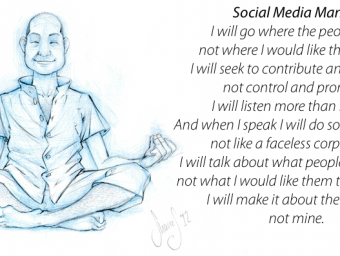The right tone of voice on social media
How to talk to your customers online...
3 Apr 2024 5981 ViewsWritten by Lena Maria Halberstadt
Raise your hand if you have used Instagram, Facebook, Twitter, LinkedIn or WhatsApp today. You are not alone. I plead guilty and with us there are 2.62 more billion people, who are active social network users (Statista, 2018). Let’s try another one. Raise your hand if you are following a brand on social media. Great, me too! Just on Instagram, 80% of users follow at least one brand (Clarke, 2018).
Social media is changing the way we communicate
Social media has a great impact on our life. It is changing the way we communicate, collaborate and connect with others. We as consumers take on active roles and are no longer passive participants in the marketing exchange process (Hanna, Rohm, & Crittenden, 2011). Social media has provided us with a great platform to follow, interact and engage with brands. Thus, it is more and more important for companies to recognize the opportunity of using social media as an interactive consumer-brand platform. Businesses can interact with their followers in a more interpersonal way and engage in dialogue and two-way communication (Park & Lee, 2013; Kelleher, 2009), which builds a profound basis for creating brand communities, relationships and a better understanding of customers (Labrecque, 2014).
But how do brands best leverage this digital change in communication? Brands must think about how they represent themselves and address their customers. Thus, this blog post delves into the importance of your company’s tone of voice in today’s highly interactive and communicative environment, elaborating which style of communication is most suitable for your company.
Tone of voice Social Media – what are we talking about?
Social media is built upon seven functional blocks, namely identity, conversations, sharing, presence, relationships, reputation and groups. Together these elements build the social media presence of your firm and determine the social media user experience (Kietzmann, Hermkens, McCarthy & Silvestre, 2011). An important aspect of the brand communication on social media involves the tone of voice, which affects all seven functions on social media.
The concept of Social Media tone of voice is often not the first thing that comes into your mind with regard to brand communication. However, this should not diminish its importance. A company’s tone of voice describes the manner in which the personality and brand values are conveyed in written, verbal and visual communication. It is less about what is said and much more about the way it is said (Barcelos, Dantas & Sénécal, 2018). In fact, it encompasses the words you choose as well as their order, rhythm and pace. The brand voice on social media also influences the impression everyone gets when they hear or read your company’s message (Moran, 2016).
How to communicate on Social Media?
There are different styles how brands can communicate online. Social media already personifies brands as it enables communication and engagement with customers. However, the pattern of your communication, the tone of voice, refers to the humanness of your communication (Barcelos et al., 2018) as well as the level of interaction (Kelleher, 2009). Generally, we can distinguish between a corporate (formal) and a human (informal) tone of voice.
Being human; being successful?
You may have noticed that some companies communicate in a very formal and professional way on social media. This type of communication is referred to as a corporate voice. It has long been a sign of reliability, trust and intelligence (Halstead, 2017). Recently however there has been a shift in online communication.
More and more firms are using a humanized approach in their content marketing. The human voice can be described as “an engaging and natural style of organizational communication as perceived by an organization’s publics based on interactions between individuals in the organization and individuals in publics” (Kelleher, 2009, p. 177). Even though brands are no real human beings per se, consumers relate to them as if they are (Fournier, 1998). People like it when a brand seems to have a personality that they can meet, recognize, and relate to. This is consistent with the current trend towards honesty, openness and authenticity in the business world and the fact that emotions, rather than pure, hard logic, often win customers over to your brand. Studies have proven that a human voice of brand is positively linked to trust, satisfaction, commitment, relationship building and control mutuality (e.g. Kelleher, 2009; Park & Lee, 2013).
Roxy: a great example for a human tone of voice
Roxy, a surf, snowboard and fitness clothing brand, is a great example of a firm that uses a humanized tone of voice on various social media channels. The usage of smileys and questions towards the audience shows that Roxy has a dialogic communication intention. Roxy aims to interact with consumers and represents itself as a human being. Their social media presence is friendly, chatty, and offbeat.
Goldman Sachs: a great example for a corporate tone of voice
Goldman Sachs, a leading global investment banking, securities and investment management firm, is using a corporate tone of voice on social media. As you can see in the example on Twitter, Goldman Sachs is informing their followers about a panel discussion, but is not interacting with them. Also, the language used is rather formal. Goldman Sachs’ social media presence is thus rather informative, traditional and less interactive.
Guide: Should your brand use a human tone of voice?
A brand’s tone of voice should embody and express a brand’s personality and set of values. But now the question arises: how can you choose the tone of voice that suits best to your company? No worries, I can help you with that. I developed a guide with 4 steps that will support you in defining whether a human or corporate tone of voice is more advisable for your brand.
#1 Product characteristics
One study has shown that the tone of voice is related to consumer goals and the level of situational involvement. If consumers associate your product or service with high involvement and risk, it is recommendable to use a corporate voice on social media. In contrast, if your product or service is usually purchased in a low involvement and risk context, it is most suitable to integrate a human voice (Barcelos et al., 2018). For instance, customers of Roxy associate the products with low risk and get less involved. Consumers mainly associate hedonic values to the product. Thus, the human voice of tone is most suitable for Roxy. However, for a company such as a Goldman Sachs a more corporate approach is advisable since the product is associated with high risks, utilitarian attributes and is usually purchased in a high situational involvement context.
#2 Aligned with brand personality
The tone of voice should align with your company’s core values and brand personality. If you present your company as something that it’s not, it could be irritating for your customers. For sure they will recognize it, which can backfire very quickly. Essentially, it is all about being your true self and being as authentic as possible (Moran, 2016).
#3 Customer Expectations
The customers are the ones who are purchasing your products or are using your service. Thus, it is most crucial that consumers perceive the tone of voice as appropriate for your company. Consumers expect brands to behave according to social norms, which implies using the right tone of voice for the right type of company (Gretry, Horváth, Belei & van Riel, 2017). There are a number of companies, who have misjudged this dimension of the tone of voice. For instance, a company, who targets people above the age of 50, should not use the slang of teenagers just to seem younger. It is important that you stay true to yourself.
#4 Be consistent, unique and recognizable!
Use your brands tone of voice to set yourself apart from the competition. Your tone of voice should be unique, distinctive and recognizable. Adhering to a well-defined style of writing helps you build a consistent brand image. It ensures consistency in style, spelling and grammar and also helps your clients feel like they’re talking to the same person each time they interact with your brand (Brinkman, 2017).
Let’s sum it up – Tone of voice is very important!
Your brand’s tone of voice has a tremendous impact on how consumers perceive your brand online. Thus, it is crucial to choose a communication style that fits to your product characteristics, your brand personality and your customer base. Moreover, the consistency, uniqueness, and distinctness of your brand’s tone of voice is important. Taking all of these factors into consideration, you will be able to generate favorable relational outcomes in terms of trust, satisfaction and commitment. Above all, you should always remember that the content you post should be genuinely useful to your clients.
References
Altmann, G. (2016). Interaction. Available Online: https://pixabay.com/en/interaction-social-media-abstract-1233873/ [Accessed 28 November 2018]
Barcelos, R. H., Dantas, D. C. and Sénécal, S. (2018). Watch Your Tone: How a Brand’s Tone of Voice on Social Media Influences Consumer Responses. Journal of Interactive Marketing. Vol. 41, pp. 60-80. Available through: LUSEM Library website: https://ac.els-cdn.com/S1094996817300579/1-s2.0-S1094996817300579-main.pdf?_tid=d229e153-580e-4f97-88f5-d63102168506&acdnat=1543309280_5abff9a97c1f89f4ef138192214955ae [Accessed 23 November 2018]
Brinkman, A. (2017). The Power of Consistent Branding That Tells A Story. Forbes. Available Online: https://www.forbes.com/sites/forbescommunicationscouncil/2017/02/15/the-power-of-consistent-branding-that-tells-a-story/#78f2d3b51302 [Accessed 26 November 2018]
Clarke, T. (2018). 24+ Instagram Statistics That Matter to Marketers in 2019. Available Online: https://blog.hootsuite.com/instagram-statistics/ [Accessed 25 November 2018]
Fournier, S. (1998). Consumers and their Brands: Developing Relationship Theory in Consumer Research. Journal of Consumer Research. Vol. 24, no. 4, pp. 343–73. Available through: LUSEM Library website: http://eds.a.ebscohost.com/eds/pdfviewer/pdfviewer?vid=0&sid=cce6a1fb-2ef3-406c-bf67-88e1871d2f23%40sessionmgr4007 [Accessed 22 November 2018]
Gretry, A., Horváth, C., Belei, N. & van Riel, A. C. (2017). “Don’t pretend to be my friend!” When an informal brand communication style backfires on social media. Journal of Business Research Vol. 74, pp. 77-89. Available Online: https://ac.els-cdn.com/S0148296317300255/1-s2.0-S0148296317300255-main.pdf?_tid=f2366eba-3db1-4f47-8216-8021d84055da&acdnat=1543322486_595d8de7a6047a54d95d165bcec1dd97 [Accessed 25 November 2018]
Halstead (2017). Your Brand Voice: Content marketing isn’t strictly business anymore. Available Online: https://www.halsteadmedia.com/blog/your-brand-voice [Accessed 21 November 2018]
Hanna, R., Rohm, A., and Crittenden, V. L. (2011). We’re all connected: The power of the social media ecosystem. Business Horizons. Vol. 54, no. 3, pp. 265–273. Available Online: https://doi.org/10.1016/j.bushor.2011.01.007 [Accessed 21 November 2018]
Kelleher, T. (2009). Conversational Voice, Communicated Commitment, and Public Relations Outcomes in Interactive Online Communication. Journal of Communication. Vol. 59, pp. 172-188. Available Online: http://web.b.ebscohost.com/ehost/pdfviewer/pdfviewer?vid=1&sid=1ad81284-83aa-43a3-b887-48fce8993970%40sessionmgr104 [Accessed 21 November 2018]
Kietzmann, J. H., Hermkens, K., McCarthy, I. P. and Silvestre, B. S. (2011). Social media? Get serious! Understanding the functional building blocks of social media. Business Horizons. Vol. 54, pp. 241-251. Available Online: https://ac.els-cdn.com/S0007681311000061/1-s2.0-S0007681311000061-main.pdf?_tid=9f1a5874-e9d3-4337-b17f-e5d128fe06eb&acdnat=1543322610_50053d13fa42036b90d2206ac5171932 [Accessed 23 November 2018]
Labrecque, L. I. (2014). Fostering Consumer-Brand Relationships in Social Media Environments: The Role of Parasocial Interaction. Journal of Interactive Marketing. Vol. 28, pp. 134-148. Available Online: https://ac.els-cdn.com/S1094996813000650/1-s2.0-S1094996813000650-main.pdf?_tid=433a9909-f464-484c-8261-1f1c01cc628d&acdnat=1543322665_042b7523e7eac7f6eb31bc623765a6c2 [Accessed 23 November 2018]
Moran, K. (2016). The Four Dimensions of Tone of Voice. Available Online: https://www.nngroup.com/articles/tone-of-voice-dimensions/ [Accessed 23 November 2018]
Park, H. and Lee, H. (2013). Show Us You Are Real: The Effect of Human-Versus-Organizational Presence on Online Relationship Building Through Social Networking Sites. Cyberpsychology, Behavior, and Social Networking. Vol. 16, no. 4, pp. 265-271. Available Online: http://eds.a.ebscohost.com/eds/pdfviewer/pdfviewer?vid=0&sid=9d9d4e5c-ce71-47d2-8aef-1feff6cb5668%40sessionmgr4007 [Accessed 23 November 2018]
Statista. (2018). Number of social network users worldwide from 2010 to 2021 (in billions). Available Online: https://www.statista.com/statistics/278414/number-of-worldwide-social-network-users/ [Accessed 21 November 2018]
Twitter (2018a) Roxy. Available Online: https://twitter.com/Roxy [Accessed 24 November 2018]
Twitter (2018b) Goldman Sachs. Available Online: https://twitter.com/GoldmanSachs [Accessed 24 November 2018]
Like this post? You'll find more marketing insights in my new book: International Brand Strategy: A guide to achieving global brand growth, now available from booksellers globally. Order your copy here.







